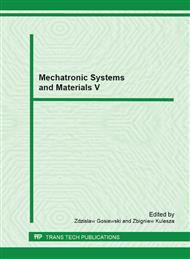p.3
p.9
p.15
p.21
p.27
p.33
p.43
p.49
p.55
Fundamental Laws of Rolling-Element Bearing Mechanics and Diagnostic Methods FAM-C and FDM-A
Abstract:
Rolling-element bearings have been used in the engineering practice since the very beginning of the XIX century. The scientific literature on the subject is therefore rich. As rotational speeds of bearing shafts were getting higher, new problems appeared. Quite a new challenge to be faced were turbine engines with very high rotational speeds that considerably augmented both the scope of problems and the demand for fast and reliable diagnostic methods. The FDM-A diagnostic method (FM frequency modulation, D direct current, C - the level of the methods advancement) has been based on measurements of frequency modulation of the component of pulsation whereas the FAM-C method (FM frequency modulation, C alternating current, C - the level of the methods advancement, i.e. applications in the form of an automatic tester are in use) has been based on measurements of the alternating-current frequency. Both the methods have been developed at ITWL (Air Force Institute of Technology), Warsaw, Poland. Accuracy of these methods essentially results from the natural synchronization of the sampling signal with the angular velocity of kinematic links under examination. The methods enable abrasive wear of a given subassembly to be determined and localised in the course of the power plants regular operation. Possible is determination of numerous parameters of the bearings themselves, the bearing nodes, and the rotating (compressor-turbine) assembly, just to mention the degree of the rolling friction for any of the bearings, the smoothness of motion of the bearing cage, sizes of radial clearances, the level of abrasive wear of contact surfaces of both the bearing cage and the rolling element. A diagnostic unit is fitted to any item, e.g. an electrical joint, supplied with DC or AC voltage. What has been presented in the paper is findings from the performance testing of the aircraft turbine engine: the role of the generator observer has been played by a DC generator and a three-phase tachogenerator.
Info:
Periodical:
Pages:
27-32
Citation:
Online since:
March 2013
Authors:
Price:
Сopyright:
© 2013 Trans Tech Publications Ltd. All Rights Reserved
Share:
Citation:


